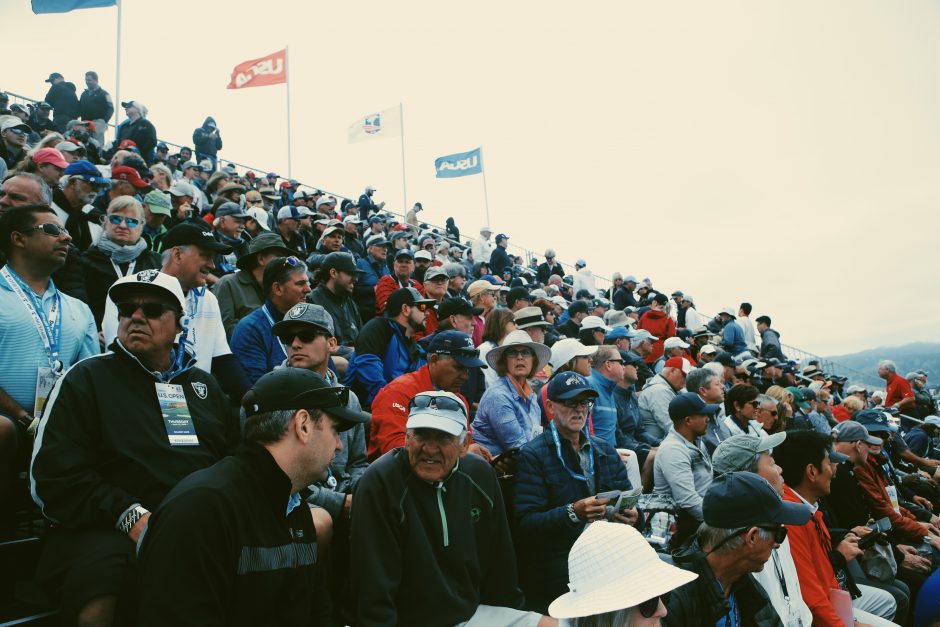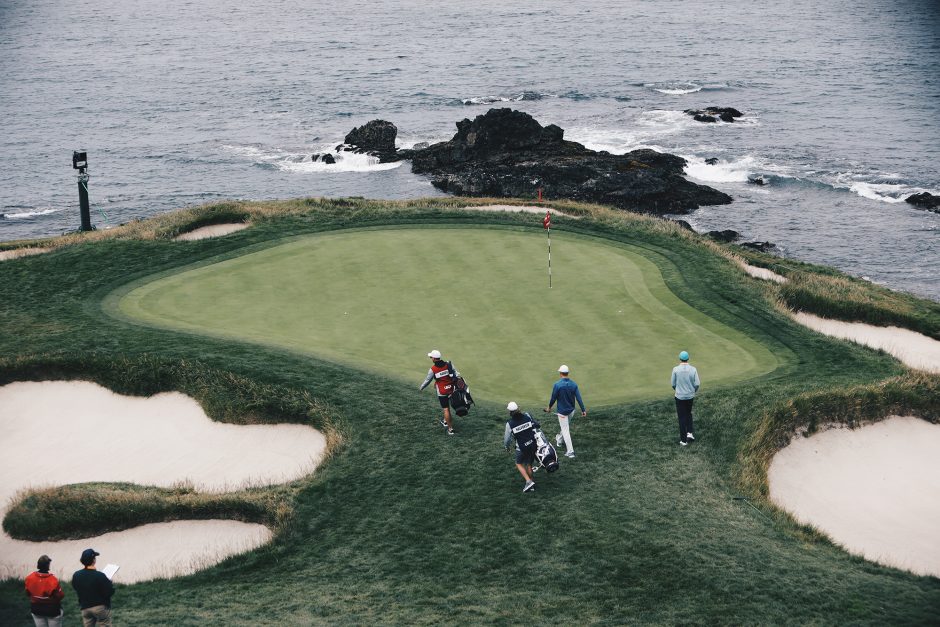A Morning on the 7th Hole at the U.S. Open
What’s the equivalent of seats on the 50-yard line at the U.S. Open?
How about three hours in the middle of the most beautiful 120 yards in sports – the grandstands on the seventh hole at Pebble Beach.
It’s 10 a.m. during Thursday’s opening round and the grandstands are already full. Waves of fans are surging in and out. Some are hanging for half a day with their prime seats along the top railing, where they can also peer into the sixth and eighth holes behind them. Others retreat once they see a birdie and move on to their next must-see stop. A sign announces that the grandstands are already full, but the wait is no more than a group or two to find a seat.
Colorful yachts bob up and down behind the seventh tee on Stillwater Cove, and a paddle boarder circles the green at the tip of Arrowhead Point. The coast guard soon pulls up to within a wedge shot of the green, and the orange-clad crew hops onto the deck to sneak in a few U.S. Open views.
Welcome to the world’s most beautiful stadium. Three sections of grandstands rise for 20 rows, dwarfing the square footage of the green everyone is glued to below.
The ambiance is the quiet chatter of a baseball game, with a view that blows away a Giants game overlooking McCovey Cove: the arch rocks and the 18th tee to your right, Point Lobos and the most felicitous meeting of land and sea to your left, and an endless horizon of ocean straight ahead. Throw in the soundtrack of birds soaring overhead and the whoosh of the ocean as players settle in for their shots, and you’ve got the most popular perch at Pebble Beach.

The ambiance is the quiet chatter of a baseball game, with a view that blows away a Giants game overlooking McCovey Cove.
The likes of Rory McIlroy, Dustin Johnson, Phil Mickelson, Brooks Koepka and Tiger Woods are hours away from reaching the seventh hole, but this is still the place to be. The grandstands across Stillwater Cove at the 17th hole are maybe half full, and the 18th green reaches a high-water mark two-thirds of the way up.
Fans pull out their tee sheets and study the groups on deck. They place bets on who will hit it closest to the hole, then give each other odds on the birdie putts. Between play, they banter about their favorite swings, crowdsource local dinner options and marvel at the tiny size of the seventh green.
Two hours in it’s joked that there hasn’t been a hole-in-one yet. It’s a quip worth contemplating. The seventh hole is just 109 yards, the shortest in Major championship golf. It looks so close you think you can throw a ball on the green. And the wind is barely rustling the sleeves of the best golfers on the planet as they take back their wedge.
But then you think – it’s been two hours, and every single player has hit the green. How incredible is that?
The pin is nuzzled against a nob along the right edge of the green. The wind is quartering in off the ocean. Think the hour hand when it’s 7 o’clock. The only way to knock it tight is to fly it 5 feet past the flag, and then watch the ball jerk back like a yoyo. Two lefties hold draws perfectly into the wind to set-up 5-footers for birdie – Mike Weir and Mickelson.
Halfway to the green, Mickelson squeezes an extra cheer from the gallery by flashing his patented thumbs up to the fans. The crowd shows a more playful side with McIlroy, briefly chanting “Rory!” after a tight shot, before tauntingly switching over to “Warriors!” – a jab at him siding with the Toronto Raptors after winning the Canadian Open last week.
After watching a bucket full of wedges, you learn that the best way to make a birdie is simply finding the middle of the green, and letting the wind push your ball safely left of the flag. And as players get ready to putt, you feel like you can read this green better than Bones MacKay. You’ve even been practicing your whisper-into-the-microphone announcer voice all morning.
You know that putts short of the hole snap hard to Carmel Valley, a break every pro underestimates. Putts from straight across the green roll out to Hawaii – this is the line that yields the most birdies. And putts right of the hole peel off to Point Lobos, catching the pros off guard every time – but not you, the learned grandstand viewer.
What’s even more fascinating is how different the hole plays the very next day. You can’t make the hole much tougher for the U.S. Open. Sure the green is a little faster and firmer, and the rough is a little lusher, but it’s the same shot the public faces every other week of the year. You can’t move the tee onto the coast guard boat. All that can really change is the wind and the pin position.

You can’t make the hole much tougher for the U.S. Open. All that can really change is the wind and the pin position.
With the wind puffing out toward Carmel Beach on Friday, three straight groups send tee shots bounding past a back-left pin and over the green. Any shot that hits halfway into the green can’t slam on the breaks fast enough before nestling into thick rough 15 feet behind the hole.
If only you could warn them.
“There’s a lot of groaning and moaning today,” a fan says about the gallery as she laughs.
It’s a new day on the seventh hole, a place where there’s no such thing as a bad day.
Photography by Ben Warden